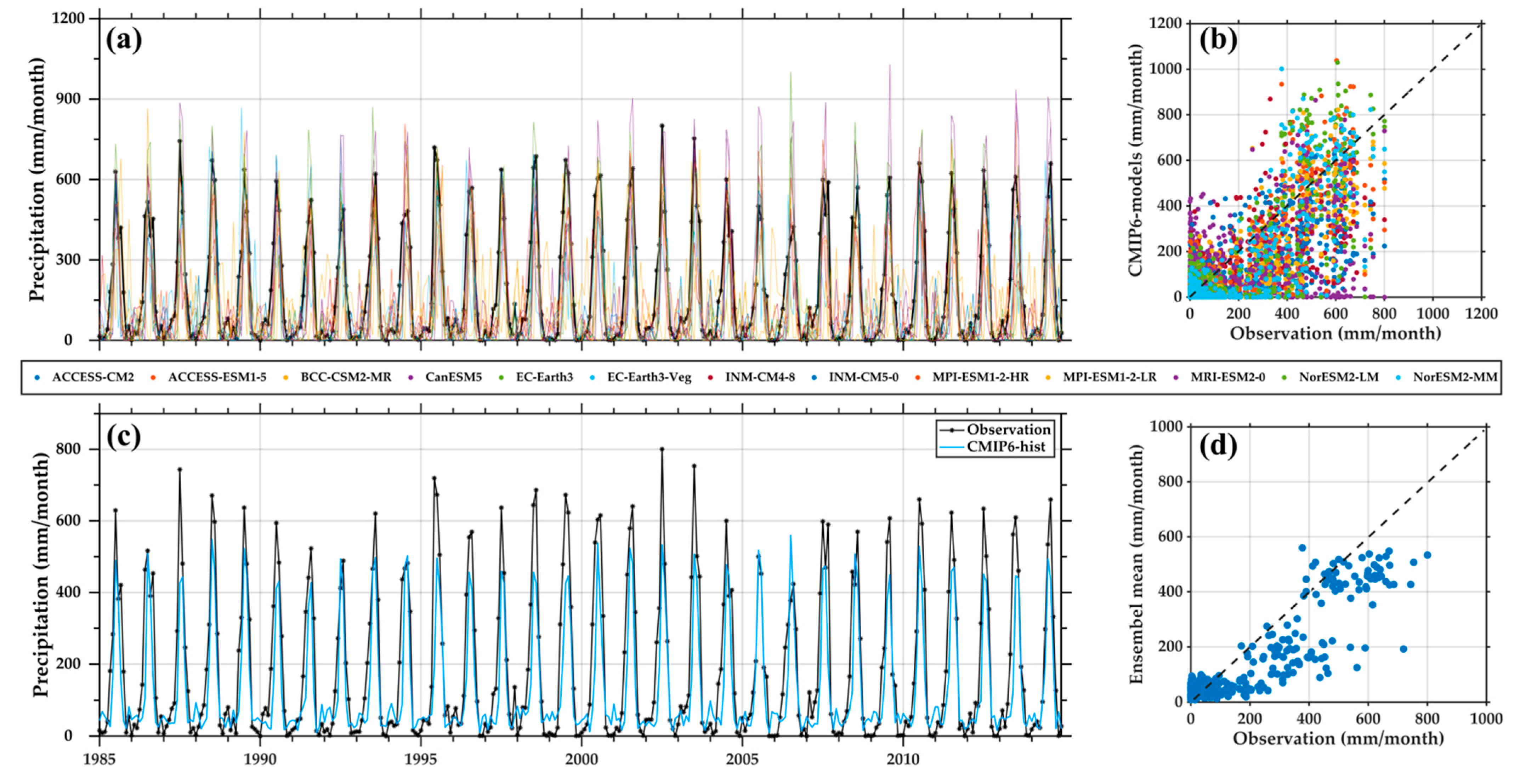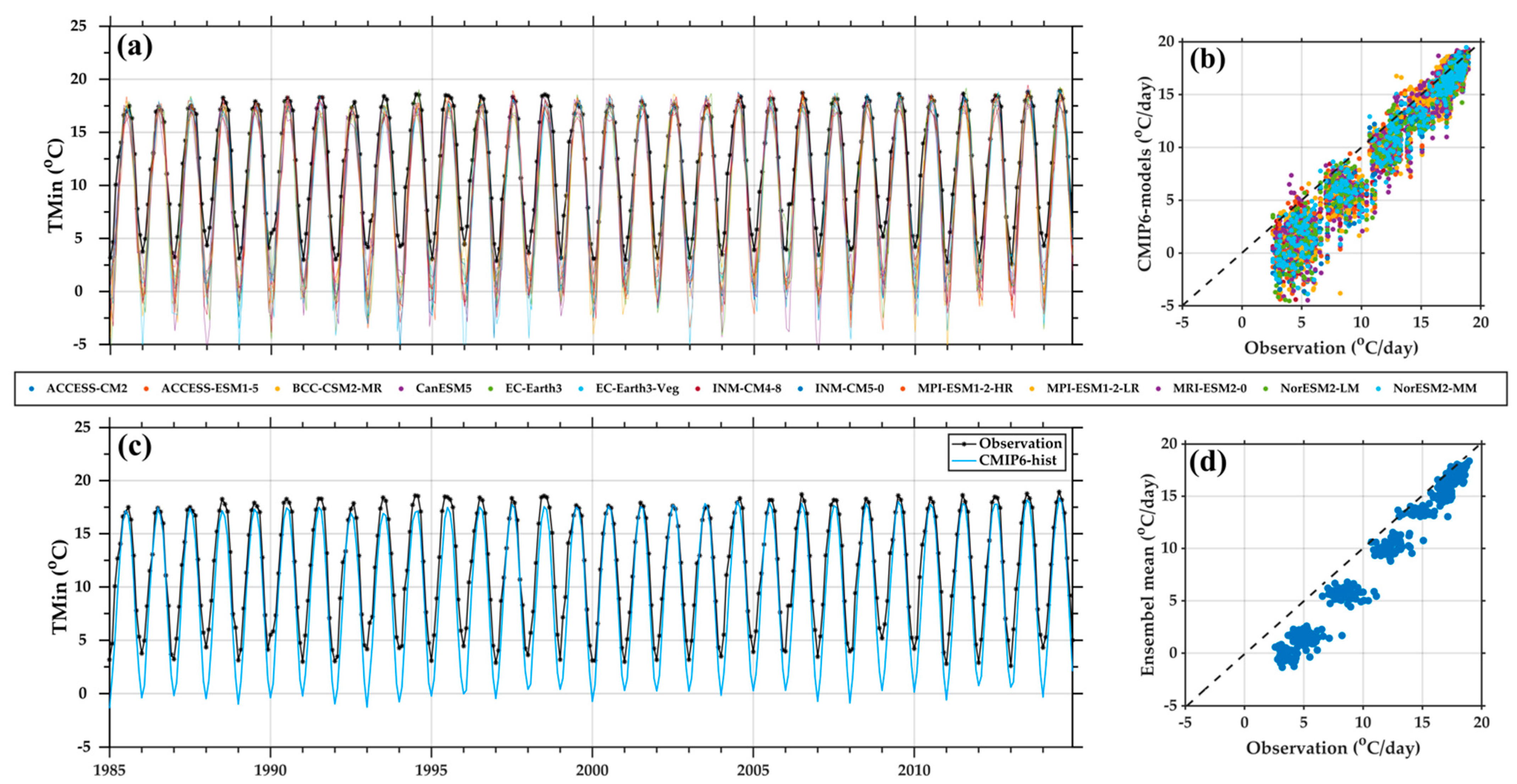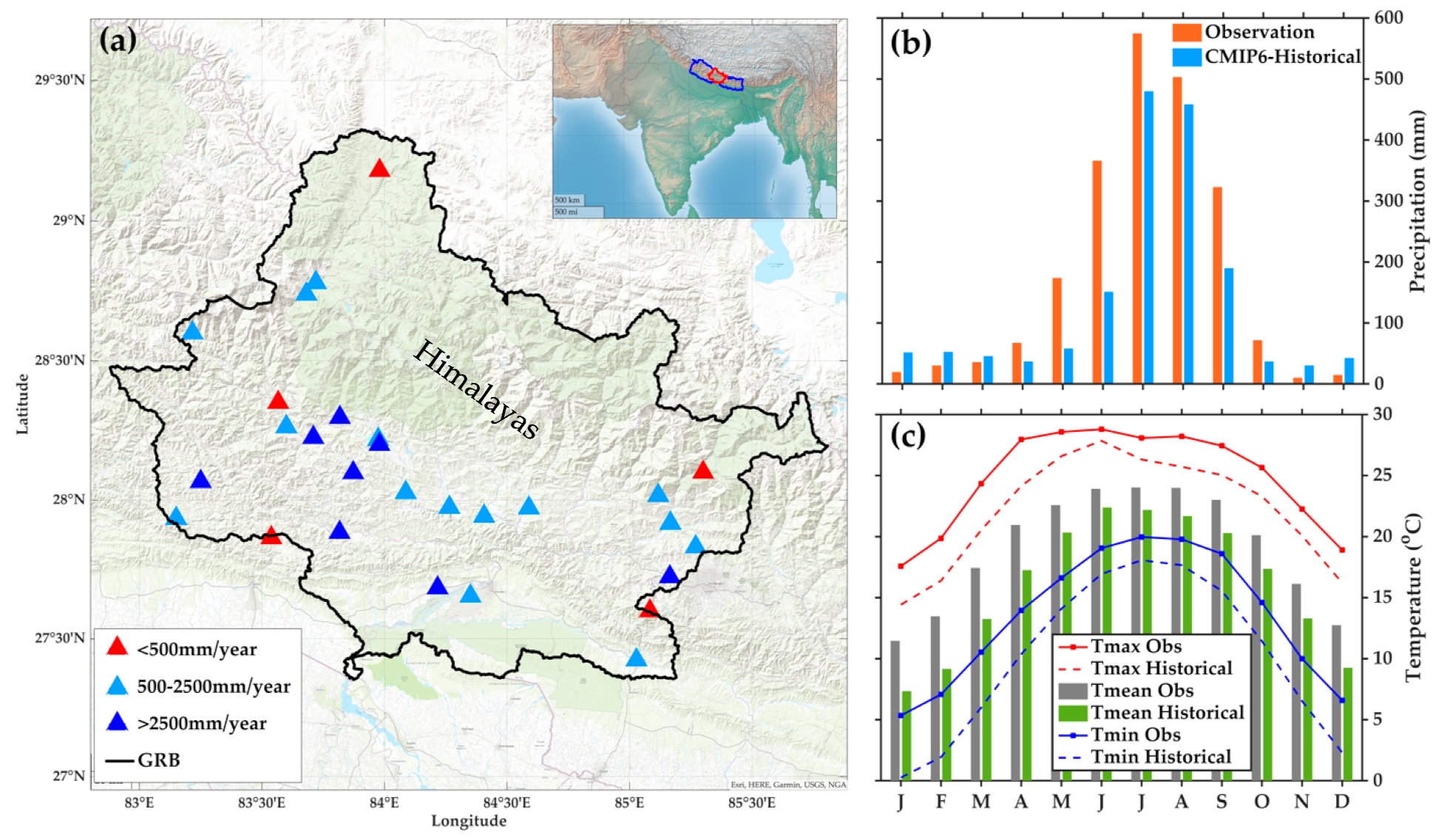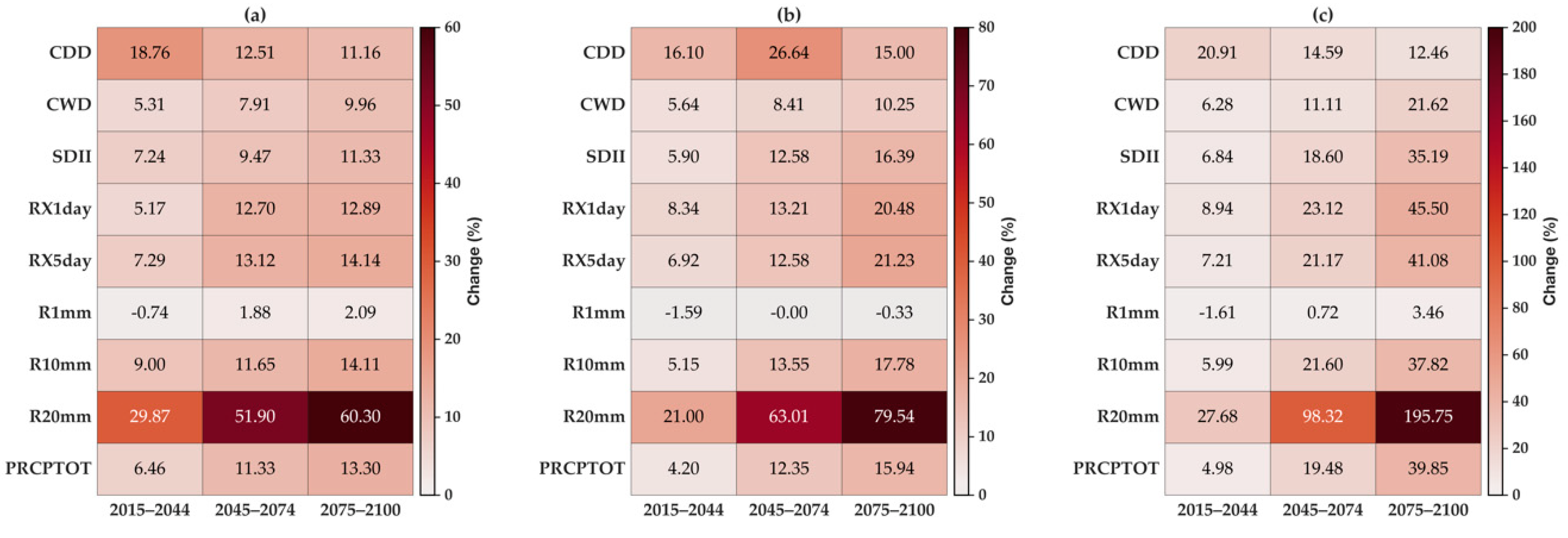Historical and Projected Variations of Precipitation and Temperature and Their Extremes in Relation to Climatic Indices over the Gandaki River Basin, Central Himalaya
Abstract
1. Introduction
2. Materials and Methods
2.1. Study Area
2.2. Data and Methodology
3. Results
3.1. Spatial Distribution of Precipitation, Temperature and their Trends
3.2. Precipitation and Temperature Extremes
3.3. Correlation between Extreme Precipitation, Temperature Indices and Ocean-Atmospheric Circulation Patterns
4. Discussion
5. Summary and Conclusions
Author Contributions
Funding
Institutional Review Board Statement
Informed Consent Statement
Data Availability Statement
Acknowledgments
Conflicts of Interest
Appendix A
| CMIP6-Models | Statistical Metrics | BIAS | R | RMSE | Pbias (%) |
|---|---|---|---|---|---|
| ACCESS-CM2 | Precipitation (mm) | −10.67 | 0.90 | 173.38 | 6.07 |
| Tmax (°C) | −2.85 | 0.92 | 3.33 | 12.85 | |
| Tmin (°C) | −2.00 | 0.97 | 2.59 | 20.50 | |
| ACCESS-ESM1-5 | Precp (mm) | −42.11 | 0.85 | 129.74 | 29.14 |
| Tmax (°C) | −2.80 | 0.93 | 3.28 | 12.59 | |
| Tmin (°C) | −2.20 | 0.98 | 2.80 | 23.03 | |
| BCC-CSM2-MR | Precp (mm) | −50.07 | 0.89 | 138.62 | 36.66 |
| Tmax (°C) | −2.89 | 0.92 | 3.40 | 13.04 | |
| Tmin (°C) | −2.35 | 0.96 | 3.08 | 25.12 | |
| CanESM5 | Precp (mm) | −55.63 | 0.81 | 261.08 | 42.46 |
| Tmax (°C) | −2.53 | 0.87 | 3.45 | 11.25 | |
| Tmin (°C) | −1.94 | 0.96 | 2.64 | 19.87 | |
| EC-Earth3 | Precp (mm) | −47.73 | 0.82 | 138.64 | 34.36 |
| Tmax (°C) | −2.73 | 0.91 | 3.36 | 12.24 | |
| Tmin (°C) | −2.14 | 0.97 | 2.85 | 22.26 | |
| EC-Earth3-Veg | Precp (mm) | −50.67 | 0.83 | 134.77 | 37.26 |
| Tmax (°C) | −2.85 | 0.92 | 3.42 | 12.82 | |
| Tmin (°C) | −2.18 | 0.97 | 2.82 | 22.84 | |
| INM-CM4-8 | Precp (mm) | −53.82 | 0.80 | 160.81 | 40.51 |
| Tmax (°C) | −2.72 | 0.91 | 3.33 | 12.20 | |
| Tmin (°C) | −2.17 | 0.98 | 2.82 | 22.75 | |
| INM-CM5-0 | Precp (mm) | −50.47 | 0.85 | 148.30 | 37.06 |
| Tmax (°C) | −2.77 | 0.92 | 3.34 | 12.43 | |
| Tmin (°C) | −2.24 | 0.98 | 2.83 | 23.63 | |
| MPI-ESM1-2-HR | Precp (mm) | −55.32 | 0.80 | 138.87 | 42.12 |
| Tmax (°C) | −2.78 | 0.92 | 3.29 | 12.51 | |
| Tmin (°C) | −2.18 | 0.97 | 2.83 | 22.77 | |
| MPI-ESM1-2-LR | Precp (mm) | −54.76 | 0.83 | 129.60 | 41.52 |
| Tmax (°C) | −2.72 | 0.90 | 3.38 | 12.18 | |
| Tmin (°C) | −2.09 | 0.96 | 2.86 | 21.72 | |
| MRI-ESM2-0 | Precp (mm) | −51.51 | 0.84 | 150.43 | 38.12 |
| Tmax (°C) | −2.96 | 0.91 | 3.58 | 13.41 | |
| Tmin (°C) | −2.31 | 0.96 | 3.05 | 24.46 | |
| NorESM2-LM | Precp (mm) | −39.73 | 0.94 | 167.43 | 27.04 |
| Tmax (°C) | −3.02 | 0.89 | 3.67 | 13.72 | |
| Tmin (°C) | −2.32 | 0.97 | 3.03 | 24.67 | |
| NorESM2-MM | Precp (mm) | −48.94 | 0.86 | 139.92 | 35.54 |
| Tmax (°C) | −2.83 | 0.90 | 3.40 | 12.74 | |
| Tmin (°C) | −2.14 | 0.98 | 2.73 | 22.28 | |
| Ensemble mean | Precp (mm) | −47.04 | 0.85 | 154.74 | 34.45 |
| Tmax (°C) | −2.80 | 0.91 | 3.40 | 12.61 | |
| Tmin (°C) | −2.17 | 0.97 | 2.84 | 22.76 |



References
- Hay, J.; Mimura, N. The changing nature of extreme weather and climate events: Risks to sustainable development. Geomat. Nat. Hazards Risk 2010, 1, 3–18. [Google Scholar] [CrossRef]
- Stocker, T. Climate Change 2013: The Physical Science Basis: Working Group I contribution to the Fifth Assessment Report of the InterGovernmental Panel on Climate Change; Cambridge University Press: Cambridge, UK, 2014. [Google Scholar]
- Sharma, S.; Hamal, K.; Khadka, N.; Shrestha, D.; Aryal, D.; Thakuri, S. Drought characteristics over Nepal Himalaya and their relationship with climatic indices. Meteorol. Appl. 2021, 28, e1988. [Google Scholar] [CrossRef]
- Hamal, K.; Sharma, S.; Khadka, N.; Haile, G.G.; Joshi, B.B.; Xu, T.; Dawadi, B. Assessment of drought impacts on crop yields across Nepal during 1987–2017. Meteorol. Appl. 2020, 27, e1950. [Google Scholar] [CrossRef]
- Azhar, G.S.; Mavalankar, D.; Nori-Sarma, A.; Rajiva, A.; Dutta, P.; Jaiswal, A.; Sheffield, P.; Knowlton, K.; Hess, J.J. Heat-related mortality in India: Excess all-cause mortality associated with the 2010 Ahmedabad heat wave. PLoS ONE 2014, 9, e91831. [Google Scholar] [CrossRef] [PubMed]
- Sharma, S.; Hamal, K.; Khadka, N.; Joshi, B.B.J.T.; Climatology, A. Dominant pattern of year-to-year variability of summer precipitation in Nepal during 1987–2015. Meteorol. Appl. 2020, 142, 1071–1084. [Google Scholar] [CrossRef]
- Naveendrakumar, G.; Vithanage, M.; Kwon, H.-H.; Chandrasekara, S.; Iqbal, M.; Pathmarajah, S.; Fernando, W.; Obeysekera, J. South Asian perspective on temperature and rainfall extremes: A review. Atmos. Res. 2019, 225, 110–120. [Google Scholar] [CrossRef]
- Maharana, P.; Agnihotri, R.; Dimri, A.P. Changing Indian monsoon rainfall patterns under the recent warming period 2001–2018. Clim. Dyn. 2021, 57, 2581–2593. [Google Scholar] [CrossRef]
- Talchabhadel, R.; Karki, R.; Thapa, B.R.; Maharjan, M.; Parajuli, B. Spatio-temporal variability of extreme precipitation in Nepal. Int. J. Climatol. 2018, 38, 4296–4313. [Google Scholar] [CrossRef]
- Xu, Y.; Wu, X.; Kumar, R.; Barth, M.; Diao, C.; Gao, M.; Lin, L.; Jones, B.; Meehl, G.A. Substantial Increase in the Joint Occurrence and Human Exposure of Heatwave and High-PM Hazards Over South Asia in the Mid-21st Century. AGU Adv. 2020, 1, e2019AV000103. [Google Scholar] [CrossRef]
- Huo-Po, C.; Jian-Qi, S.; Xiao-Li, C.J.A.; Letters, O.S. Future changes of drought and flood events in China under a global warming scenario. Atmos. Ocean. Sci. Lett. 2013, 6, 8–13. [Google Scholar] [CrossRef]
- Nandargi, S.; Dhar, O. Extreme rainfall events over the Himalayas between 1871 and 2007. Hydrol. Sci. J. 2011, 56, 930–945. [Google Scholar] [CrossRef]
- Panthi, J.; Dahal, P.; Shrestha, M.L.; Aryal, S.; Krakauer, N.Y.; Pradhanang, S.M.; Lakhankar, T.; Jha, A.K.; Sharma, M.; Karki, R. Spatial and temporal variability of rainfall in the Gandaki River Basin of Nepal Himalaya. Climate 2015, 3, 210–226. [Google Scholar] [CrossRef]
- DHM. Observed Climate Trend Analysis in the Districts and Physiographic Regions of Nepal (1971–2014). Dep. Hydrol. Meteorol. Kathmandu 2017, 1, 74. [Google Scholar]
- Almazroui, M.; Saeed, S.; Saeed, F.; Islam, M.N.; Ismail, M. Projections of precipitation and temperature over the South Asian countries in CMIP6. Earth Syst. Environ. 2020, 4, 297–320. [Google Scholar] [CrossRef]
- Sharma, S.; Khadka, N.; Hamal, K.; Baniya, B.; Luintel, N.; Joshi, B.B. Spatial and Temporal Analysis of Precipitation and Its Extremities in Seven Provinces of Nepal (2001–2016). Appl. Ecol. Environ. Sci. 2020, 8, 64–73. [Google Scholar]
- Dahal, P.; Shrestha, N.S.; Shrestha, M.L.; Krakauer, N.Y.; Panthi, J.; Pradhanang, S.M.; Jha, A.; Lakhankar, T.J.N.H. Drought risk assessment in central Nepal: Temporal and spatial analysis. Nat. Hazards 2016, 80, 1913–1932. [Google Scholar] [CrossRef]
- Karki, R.; Schickhoff, U.; Scholten, T.; Böhner, J. Rising precipitation extremes across Nepal. Climate 2017, 5, 4. [Google Scholar] [CrossRef]
- Oglethorpe, J.; Regmi, S.; Bartlett, R.; Dongol, B.S.; Wikramanayake, E.; Freeman, S. The value of a river basin approach in climate adaptation. Organizers 2015, 57. [Google Scholar]
- (RSS), R.S.S. Over 120 Yaks Missing in Mustang Avalanche. Onlinekhaber 2021. Available online: https://english.onlinekhabar.com/yaks-mustang-avalanche.html#:~:text=Out%20of%20a%20total%20of,however%2C%20have%20come%20to%20contact (accessed on 17 January 2022).
- Rajbhandari, R.; Shrestha, A.B.; Nepal, S.; Wahid, S.; Ren, G.-Y. Extreme climate projections over the transboundary Koshi River Basin using a high resolution regional climate model. Adv. Clim. Chang. Res. 2017, 8, 199–211. [Google Scholar] [CrossRef]
- Parajuli, A.; Devkota, L.P.; Adhikari, T.R.; Dhakal, S.; Kayastha, R.B. Impact of Climate change on river discharge and rainfall pattern: A case study from Marshyangdi River basin, Nepal. J. Hydrol. Meteorol. 2015, 9, 60–73. [Google Scholar] [CrossRef]
- Manandhar, S.; Pandey, V.P.; Kazama, F. Hydro-climatic trends and people’s perceptions: Case of Kali Gandaki River Basin, Nepal. Clim. Res. 2012, 54, 167–179. [Google Scholar] [CrossRef]
- Sharma, S.; Khadka, N.; Nepal, B.; Ghimire, S.K.; Luintel, N.; Hamal, K. Elevation Dependency of Precipitation over Southern Slope of Central Himalaya. Jalawaayu 2021, 1, 1–14. [Google Scholar] [CrossRef]
- Hamal, K.; Sharma, S.; Baniya, B.; Khadka, N.; Zhou, X. Inter-Annual Variability of Winter Precipitation Over Nepal Coupled With Ocean-Atmospheric Patterns during 1987–2015. Front. Earth Sci. 2020, 8, 161. [Google Scholar] [CrossRef]
- Madakumbura, G.D.; Thackeray, C.W.; Norris, J.; Goldenson, N.; Hall, A. Anthropogenic influence on extreme precipitation over global land areas seen in multiple observational datasets. Nat. Commun. 2021, 12, 3944. [Google Scholar] [CrossRef] [PubMed]
- Paik, S.; Min, S.K.; Zhang, X.; Donat, M.G.; King, A.D.; Sun, Q. Determining the anthropogenic greenhouse gas contribution to the observed intensification of extreme precipitation. Geophys. Res. Lett. 2020, 47, e2019GL086875. [Google Scholar] [CrossRef]
- Mishra, V.; Bhatia, U.; Tiwari, A.D. Bias-corrected climate projections for South Asia from coupled model intercomparison project-6. Sci. Data 2020, 7, 1–13. [Google Scholar] [CrossRef]
- Riahi, K.; Van Vuuren, D.P.; Kriegler, E.; Edmonds, J.; O’neill, B.C.; Fujimori, S.; Bauer, N.; Calvin, K.; Dellink, R.; Fricko, O. The shared socioeconomic pathways and their energy, land use, and greenhouse gas emissions implications: An overview. Glob. Environ. Chang. 2017, 42, 153–168. [Google Scholar] [CrossRef]
- Hamal, K.; Sharma, S.; Khadka, N.; Baniya, B.; Ali, M.; Shrestha, M.S.; Xu, T.; Shrestha, D.; Dawadi, B. Evaluation of MERRA-2 precipitation products using gauge observation in Nepal. Hydrology 2020, 7, 40. [Google Scholar] [CrossRef]
- Core Team, R. R: A Language and Environment for Statistical Computing; R Foundation for Statistical Computing: Vienna, Austria, 2013. [Google Scholar]
- Sheffield, J.; Goteti, G.; Wood, E.F. Development of a 50-year high-resolution global dataset of meteorological forcings for land surface modeling. J. Clim. 2006, 19, 3088–3111. [Google Scholar] [CrossRef]
- Hamal, K.; Sharma, S.; Talchabhadel, R.; Ali, M.; Dhital, Y.P.; Xu, T.; Dawadi, B. Trends in the Diurnal Temperature Range over the Southern Slope of Central Himalaya: Retrospective and Prospective Evaluation. Atmosphere 2021, 12, 1683. [Google Scholar] [CrossRef]
- Sharma, S.; Hamal, K.; Khadka, N.; Ali, M.; Subedi, M.; Hussain, G.; Ehsan, M.A.; Saeed, S.; Dawadi, B. Projected Drought Conditions over Southern Slope of the Central Himalaya Using CMIP6 Models. Earth Syst. Environ. 2021, 5, 849–859. [Google Scholar] [CrossRef]
- Li, S.-Y.; Miao, L.-J.; Jiang, Z.-H.; Wang, G.-J.; Gnyawali, K.R.; Zhang, J.; Zhang, H.; Fang, K.; He, Y.; Li, C. Projected drought conditions in Northwest China with CMIP6 models under combined SSPs and RCPs for 2015–2099. Adv. Clim. Chang. Res. 2020, 11, 210–217. [Google Scholar] [CrossRef]
- Sen, P.K. Estimates of the regression coefficient based on Kendall’s tau. J. Am. Stat. Assoc. 1968, 63, 1379–1389. [Google Scholar] [CrossRef]
- Kendall, M.G. A new measure of rank correlation. Biometrika 1938, 30, 81–93. [Google Scholar] [CrossRef]
- Sharma, S.; Khadka, N.; Hamal, K.; Shrestha, D.; Talchabhadel, R.; Chen, Y. How Accurately Can Satellite Products (TMPA and IMERG) Detect Precipitation Patterns, Extremities, and Drought across the Nepalese Himalaya? Earth Space Sci. 2020, 7, e2020EA001315. [Google Scholar] [CrossRef]
- Talchabhadel, R.; Aryal, A.; Kawaike, K.; Yamanoi, K.; Nakagawa, H. A comprehensive analysis of projected changes of extreme precipitation indices in West Rapti River basin, Nepal under changing climate. Int. J. Climatol. 2020, 41, E2581–E2599. [Google Scholar] [CrossRef]
- Talchabhadel, R.; Sharma, S.; Khadka, N.; Hamal, K.; Karki, S.; Thapa, B.R. An outlook on the applicability of satellite precipitation products for monitoring extreme precipitation events in Nepal Himalaya. Weather 2022, 41, E2581–E2599. [Google Scholar] [CrossRef]
- Chen, Y.; Sharma, S.; Zhou, X.; Yang, K.; Li, X.; Niu, X.; Hu, X.; Khadka, N. Spatial performance of multiple reanalysis precipitation datasets on the southern slope of central Himalaya. Atmos. Res. 2021, 250, 105365. [Google Scholar] [CrossRef]
- Li, G.; Xie, S.-P.; He, C.; Chen, Z. Western Pacific emergent constraint lowers projected increase in Indian summer monsoon rainfall. Nat. Clim. Chang. 2017, 7, 708–712. [Google Scholar] [CrossRef]
- Long, S.-M.; Li, G.; Hu, K.; Ying, J. Origins of the IOD-like Biases in CMIP Multimodel Ensembles: The Atmospheric Component and Ocean–Atmosphere Coupling. J. Clim. 2020, 33, 10437–10453. [Google Scholar] [CrossRef]
- Duncan, J.M.; Biggs, E.M.; Dash, J.; Atkinson, P.M. Spatio-temporal trends in precipitation and their implications for water resources management in climate-sensitive Nepal. Appl. Geogr. 2013, 43, 138–146. [Google Scholar] [CrossRef]
- Smalley, M.; L’Ecuyer, T. A global assessment of the spatial distribution of precipitation occurrence. J. Appl. Meteorol. Climatol. 2015, 54, 2179–2197. [Google Scholar] [CrossRef]
- Ren, Y.-Y.; Ren, G.-Y.; Sun, X.-B.; Shrestha, A.B.; You, Q.-L.; Zhan, Y.-J.; Rajbhandari, R.; Zhang, P.-F.; Wen, K.-M. Observed changes in surface air temperature and precipitation in the Hindu Kush Himalayan region over the last 100-plus years. Adv. Clim. Chang. Res. 2017, 8, 148–156. [Google Scholar] [CrossRef]
- Shrestha, A.B.; Wake, C.P.; Dibb, J.E.; Mayewski, P.A. Precipitation fluctuations in the Nepal Himalaya and its vicinity and relationship with some large scale climatological parameters. Int. J. Climatol. 2000, 20, 317–327. [Google Scholar] [CrossRef]
- Thakuri, S.; Dahal, S.; Shrestha, D.; Guyennon, N.; Romano, E.; Colombo, N.; Salerno, F. Elevation-dependent warming of maximum air temperature in Nepal during 1976–2015. Atmos. Res. 2019, 228, 261–269. [Google Scholar] [CrossRef]
- Shankar Sharma and Binod Pokharel. Nepal under Severe Drought Condition, (Newspaper Article, The Himalayan Times, 3rd March, 2021). Available online: https://thehimalayantimes.com/opinion/nepal-under-severe-drought-condition-winter-crops-affected (accessed on 12 April 2021).
- Agarwal, A.; Babel, M.S.; Maskey, S. Analysis of future precipitation in the Koshi river basin, Nepal. J. Hydrol. 2014, 513, 422–434. [Google Scholar] [CrossRef]
- Waqas, A.; Athar, H.; Shahzad, M.I. Recent variability of the observed diurnal temperature range in the Karakoram and its surrounding mountains of northern Pakistan. In Proceedings of the 2016 AGU Fall Meeting, San Francisco, CA, USA, 12–16 December 2016. [Google Scholar]
- Durre, I. Factors Influencing the Diurnal Temperature Range in the Contiguous United States; University of Washington: Washington, DC, USA, 2000. [Google Scholar]
- Pyrgou, A.; Santamouris, M.; Livada, I. Spatiotemporal analysis of diurnal temperature range: Effect of urbanization, cloud cover, solar radiation, and precipitation. Climate 2019, 7, 89. [Google Scholar] [CrossRef]
- Change, C. Working Group I: The Scientific Basis. Third Assessment Report of the Intergovernmental Panel on Climate Change; Cambridge University Press: Cambridge, UK, 2001. [Google Scholar]
- Lee, W.-H.; Lim, Y.-H.; Dang, T.N.; Seposo, X.; Honda, Y.; Guo, Y.-L.L.; Jang, H.-M.; Kim, H. An investigation on attributes of ambient temperature and diurnal temperature range on mortality in five east-Asian countries. Sci. Rep. 2017, 7, 1–9. [Google Scholar] [CrossRef]
- Singh, N.; Mhawish, A.; Ghosh, S.; Banerjee, T.; Mall, R. Attributing mortality from temperature extremes: A time series analysis in Varanasi, India. Sci. Total Environ. 2019, 665, 453–464. [Google Scholar] [CrossRef]
- Sunoj, V.J.; Shroyer, K.J.; Jagadish, S.K.; Prasad, P.V. Diurnal temperature amplitude alters physiological and growth response of maize (Zea mays L.) during the vegetative stage. Environ. Exp. Bot. 2016, 130, 113–121. [Google Scholar] [CrossRef]
- Freychet, N.; Hegerl, G.; Mitchell, D.; Collins, M. Future changes in the frequency of temperature extremes may be underestimated in tropical and subtropical regions. Commun. Earth Environ. 2021, 2, 1–8. [Google Scholar] [CrossRef]
- Giannakopoulos, C.; Kostopoulou, E.; Varotsos, K.V.; Tziotziou, K.; Plitharas, A. An integrated assessment of climate change impacts for Greece in the near future. Reg. Environ. Chang. 2011, 11, 829–843. [Google Scholar] [CrossRef]







| S. No. | Model Name | Spatial Resolution after Bias-Correction (Degree) | Historical (Projection) |
|---|---|---|---|
| 1 | ACCESS-CM2 | 0.25 × 0.25° | 1985–2014 (2015–2100) |
| 2 | ACCESS-ESM1-5 | 0.25 × 0.25° | 1985–2014 (2015–2100) |
| 3 | BCC-CSM2-MR | 0.25 × 0.25° | 1985–2014 (2015–2100) |
| 4 | CanESM5 | 0.25 × 0.25° | 1985–2014 (2015–2100) |
| 5 | EC-Earth3 | 0.25 × 0.25° | 1985–2014 (2015–2100) |
| 6 | EC-Earth3-Veg | 0.25 × 0.25° | 1985–2014 (2015–2100) |
| 7 | INM-CM4-8 | 0.25 × 0.25° | 1985–2014 (2015–2100) |
| 8 | INM-CM5-0 | 0.25 × 0.25° | 1985–2014 (2015–2100) |
| 9 | MPI-ESM1-2-HR | 0.25 × 0.25° | 1985–2014 (2015–2100) |
| 10 | MPI-ESM1-2-LR | 0.25 × 0.25° | 1985–2014 (2015–2100) |
| 11 | MRI-ESM2-0 | 0.25 × 0.25° | 1985–2014 (2015–2100) |
| 12 | NorESM2-LM | 0.25 × 0.25° | 1985–2014 (2015–2100) |
| 13 | NorESM2-MM | 0.25 × 0.25° | 1985–2014 (2015–2100) |
| Type | ID | Indicator Name | Indicator Definitions | Unit |
|---|---|---|---|---|
| Precipitation | CDD | Consecutive dry days | Five consecutive days when rainfall < 1 mm | Days |
| CWD | Consecutive wet days | Five consecutive days when rainfall ≥ 1 mm | Days | |
| SDII | Daily precipitation intensity | Ratio of annual total precipitation to number of wet days (≥1 mm) | mm/day | |
| Rx1day | Max 1-day precipitation | Maximum amount of rain in 1 day | mm | |
| Rx5day | Max 5-day precipitation | Maximum amount of rain that falls in 5 consecutive days | mm | |
| R1 mm | Number of wet days | Annual total count when rainfall ≥ 1 mm | day | |
| R10 mm | Number of heavy rainfall days | Annual count when rainfall ≥ 10 mm | day | |
| R20 mm | Number of extreme rainfall days | Annual count when rainfall ≥ 20 mm | day | |
| PRCPTOT | Annual total wet days | Total wet days of rainfall | mm | |
| Temperature | DTR | Diurnal Temperature Range | Average range of max and min temperature | °C |
| TMm | Mean average temperature | Average daily mean temperature | °C | |
| TXm | Mean daily max temperature | Average daily max temperature | °C | |
| TNm | Mean daily min temperature | Average daily min temperature | °C | |
| TNx | Warmest daily night temperature | Hottest night | °C | |
| TXn | Coldest day temperature | Coldest day | °C | |
| FD | Frost days | Annual count when daily minimum temperature < 0 °C | days | |
| SU | Summer days | Annual count when daily max temperature > 25 °C | days | |
| TR | Tropical nights | Annual count when daily min temperature > 20 °C | days | |
| TMge5 | Mean temperature of at least 5 °C | Days when average temperature is 5 °C | days | |
| TMlt5 | Mean temperature below 5 °C | Days when average temperature is below 5 °C | days | |
| TMge10 | Mean temperature of at least 10 °C | Days when average temperature is 10 °C | days | |
| TMlt10 | Mean temperature below 10 °C | Days when average temperature is below 10 °C | days | |
| TMge30 | Max temperature of at least 30 °C | Days when max temperature is at least 30 °C | days |
| Reference | SSP1-2.6 | SSP2-4.5 | SSP5-8.5 | |||||||||
|---|---|---|---|---|---|---|---|---|---|---|---|---|
| Prec | Tmax | Tmin | Prec | Tmax | Tmin | Prec | Tmax | Tmin | Prec | Tmax | Tmin | |
| Pre-Monsoon | 0.003 | 0.019 ** | 0.027 ** | 0.170 | 0.010 ** | 0.009 ** | 0.271 ** | 0.021 ** | 0.025 ** | 0.521 ** | 0.051 ** | 0.057 ** |
| Monsoon | 4.03 ** | 0.013 ** | 0.033 ** | 1.612 ** | 0.009 ** | 0.009 ** | 3.111 ** | 0.018 ** | 0.028 ** | 8.971 ** | 0.043 ** | 0.061 ** |
| Post-Monsoon | 0.565 | 0.016 ** | 0.029 ** | 0.140 | 0.008 ** | 0.009 ** | 0.123 | 0.035 ** | 0.025 ** | 0.839 ** | 0.04 ** | 0.059 ** |
| Winter | −0.246 | 0.030 ** | 0.032 ** | 0.074 | 0.014 ** | 0.012 ** | −0.038 | 0.024 ** | 0.034 ** | 0.143 ** | 0.069 ** | 0.075 ** |
| Annual | 4.098 * | 0.020 ** | 0.031 ** | 2.070 ** | 0.010 ** | 0.011 ** | 3.428 ** | 0.021 ** | 0.028 ** | 10.04 ** | 0.051 ** | 0.064 ** |
Publisher’s Note: MDPI stays neutral with regard to jurisdictional claims in published maps and institutional affiliations. |
© 2022 by the authors. Licensee MDPI, Basel, Switzerland. This article is an open access article distributed under the terms and conditions of the Creative Commons Attribution (CC BY) license (https://creativecommons.org/licenses/by/4.0/).
Share and Cite
Sigdel, K.P.; Ghimire, N.P.; Pandeya, B.; Dawadi, B. Historical and Projected Variations of Precipitation and Temperature and Their Extremes in Relation to Climatic Indices over the Gandaki River Basin, Central Himalaya. Atmosphere 2022, 13, 1866. https://doi.org/10.3390/atmos13111866
Sigdel KP, Ghimire NP, Pandeya B, Dawadi B. Historical and Projected Variations of Precipitation and Temperature and Their Extremes in Relation to Climatic Indices over the Gandaki River Basin, Central Himalaya. Atmosphere. 2022; 13(11):1866. https://doi.org/10.3390/atmos13111866
Chicago/Turabian StyleSigdel, Krishna Prasad, Narayan Prasad Ghimire, Bhopal Pandeya, and Binod Dawadi. 2022. "Historical and Projected Variations of Precipitation and Temperature and Their Extremes in Relation to Climatic Indices over the Gandaki River Basin, Central Himalaya" Atmosphere 13, no. 11: 1866. https://doi.org/10.3390/atmos13111866
APA StyleSigdel, K. P., Ghimire, N. P., Pandeya, B., & Dawadi, B. (2022). Historical and Projected Variations of Precipitation and Temperature and Their Extremes in Relation to Climatic Indices over the Gandaki River Basin, Central Himalaya. Atmosphere, 13(11), 1866. https://doi.org/10.3390/atmos13111866






